#Shaba Province
Explore tagged Tumblr posts
Text
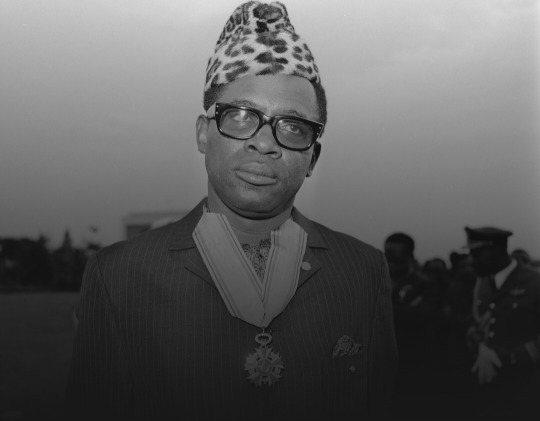
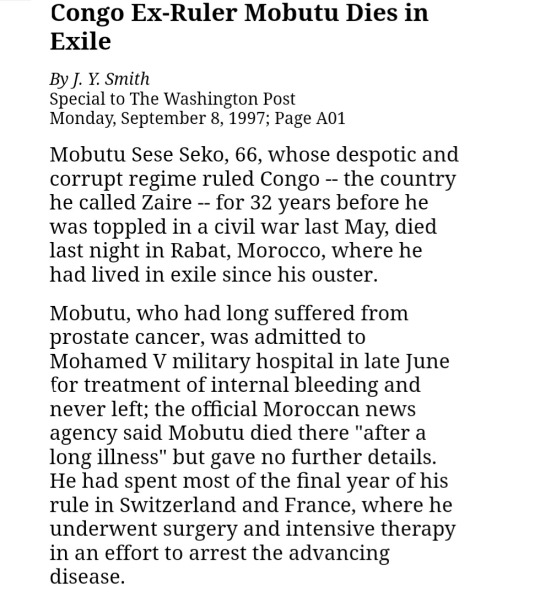
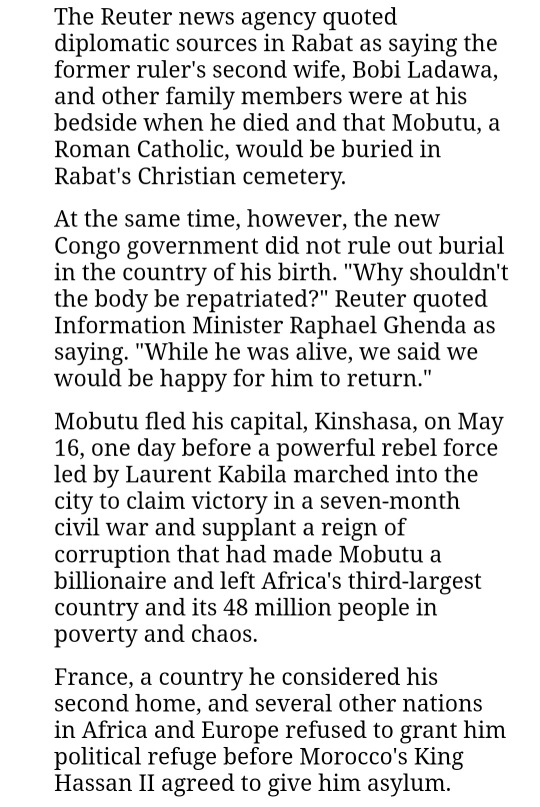

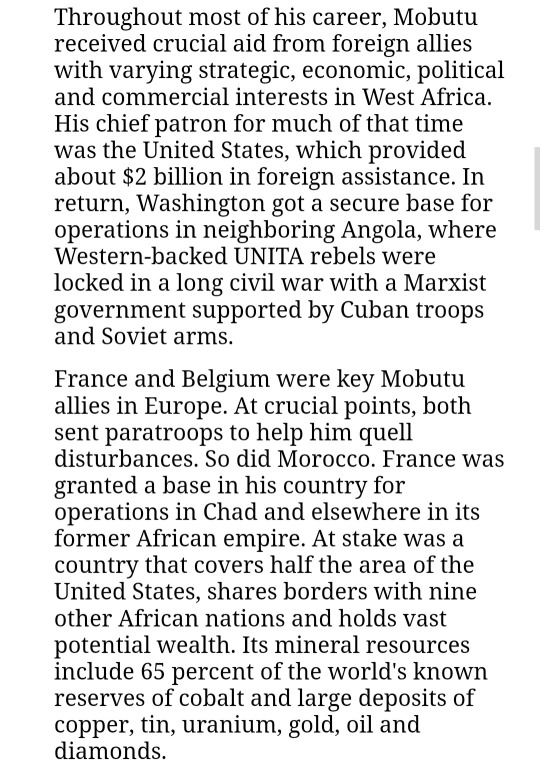
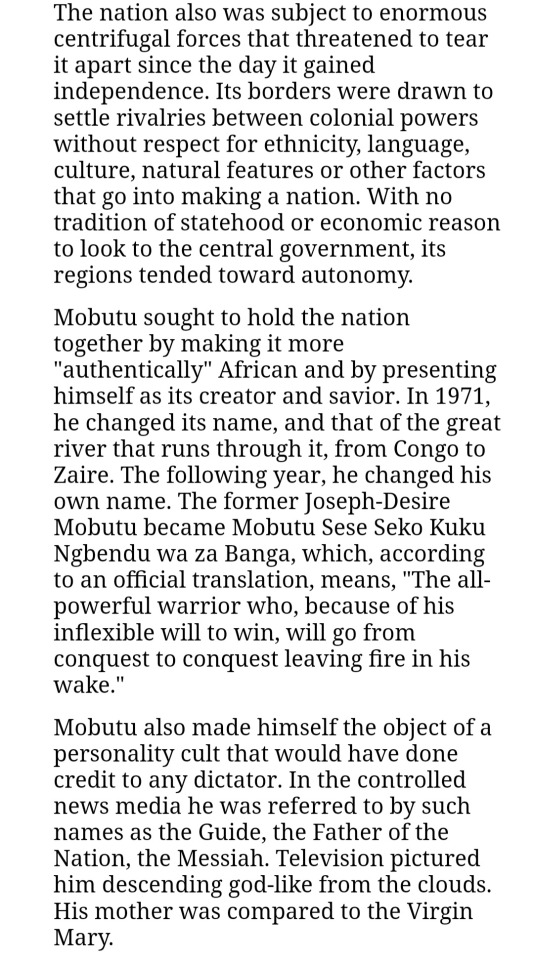
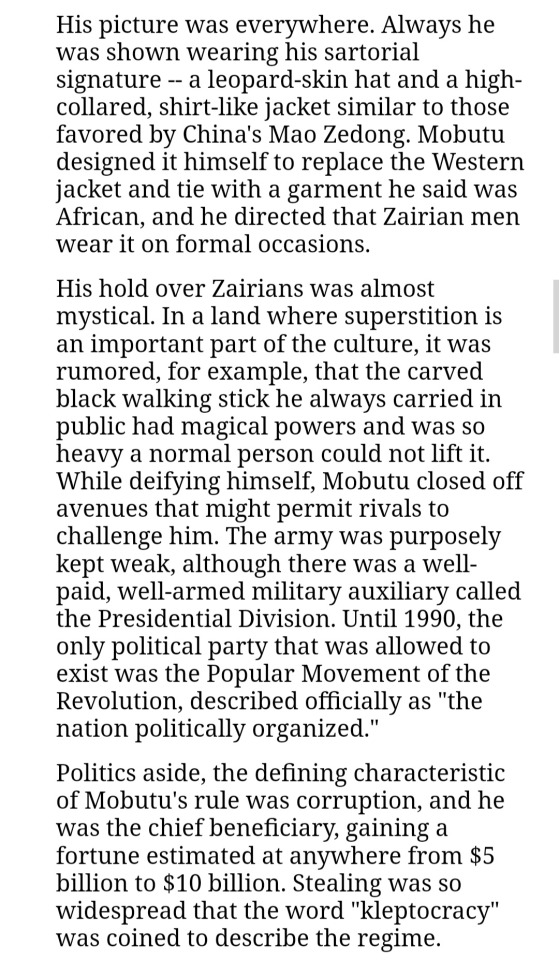
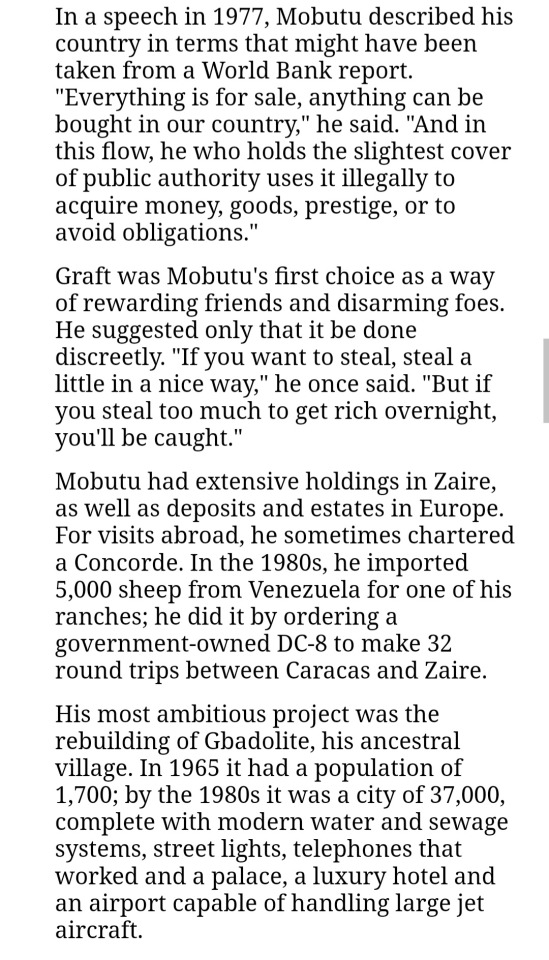
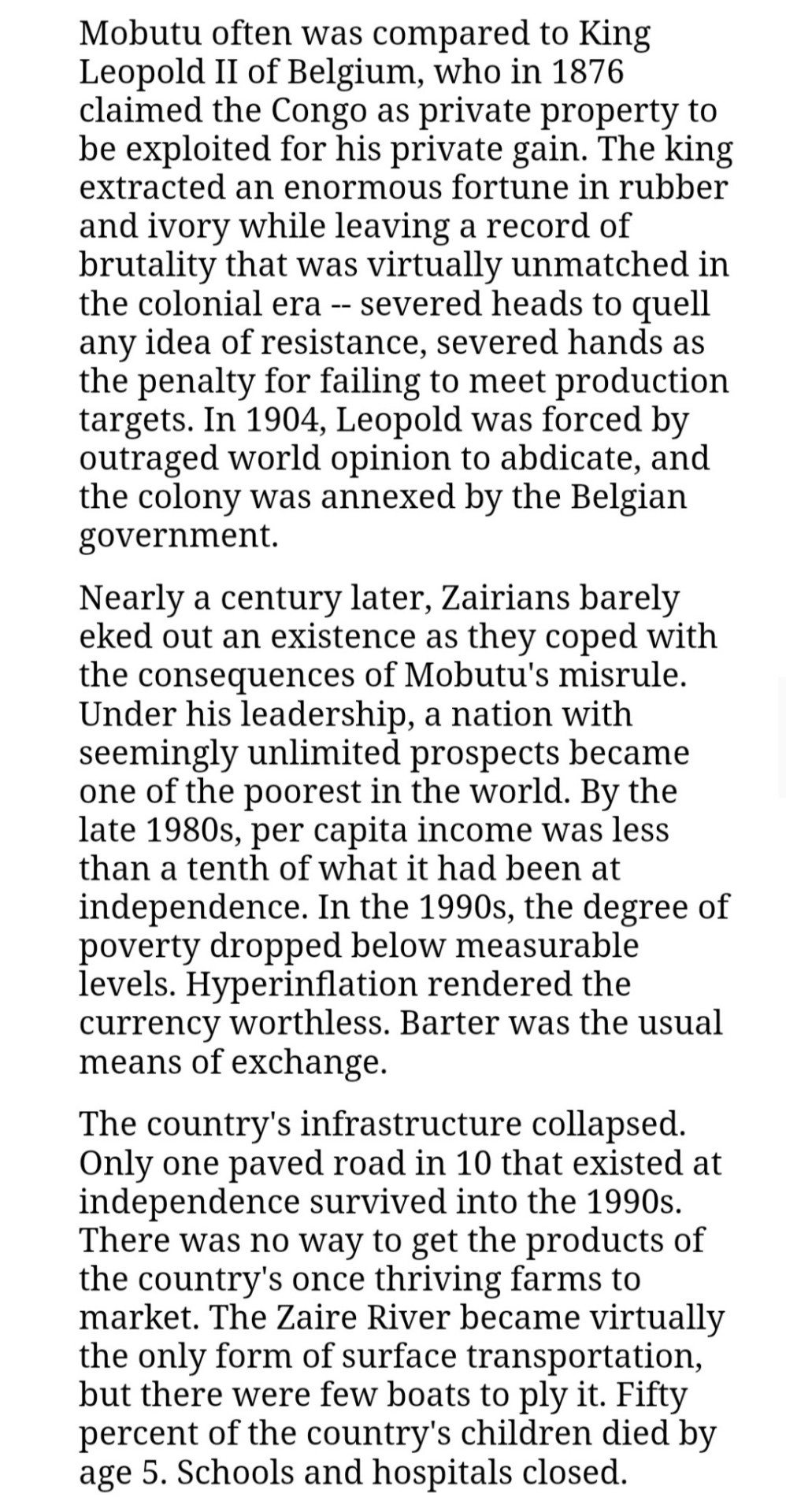
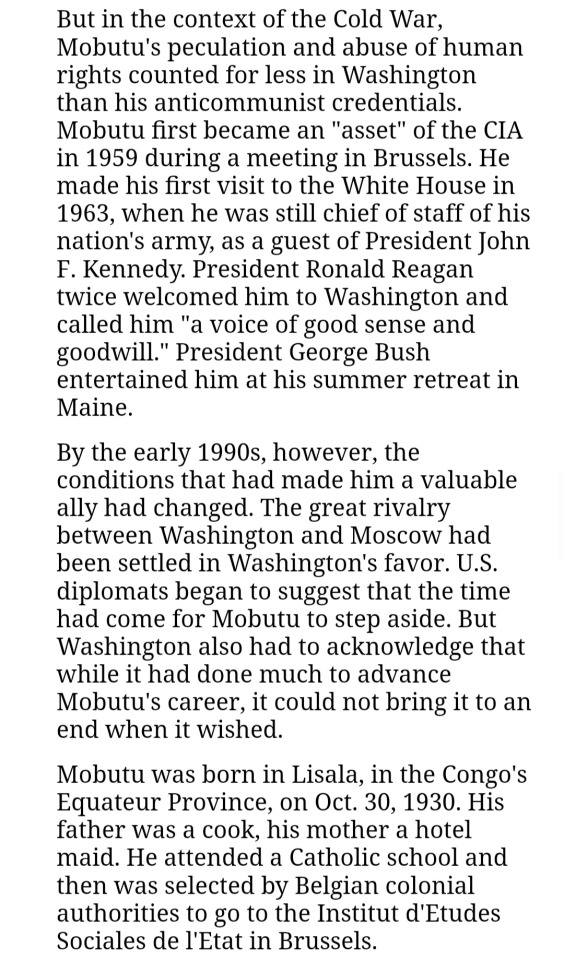
In 1949, after a year of study, he returned home and joined the Force Publique, the colonial army. He rose to the rank of sergeant major, the highest available to a Congolese. In 1956, he returned to journalism and politics, working on news0apers and magazines in Leopoldville, now Kinshasa.
In 1958, he joined the Mouvement Nationale Congolais, a political party founded by Patrice Lumumba, a left-leaning nationalist; the party's program was independence for the Congo. A year later, rioting broke out in the colony, and the Brussels government abruptly decided to grant independence. Little had been done to prepare for it - out of a population of about 15 million at the time there were only 16 university graduates.
In January 1960, a conference was held in Brussels. The question of independence had been decided, but the details had to be worked out to determine whether they wanted a strong central government or broad regional autonomy. Lumumba favored the former; representatives of the copper-rich province of Katanga, now called Shaba, favored the latter.
Having been jailed for agitation, Lumumba could not attend the meeting. Mobutu went as his chief representative and successfully argued for a centralized regime. On June 20, 1960, Belgium transferred power to a coalition government in which Joseph Kasavubu was president, Lumumba premier and Mobutu defense minister.
Eight days later, the army revolted and turned on its Belgian officers. On July 11, Katanga seceded under the leadership of Moise Tshombe. Subsequently, secessionist movements arose in Kasai and Orientale provinces, and the Congo was plunged into a crisis that seemed to confirm the worst fears of Africa's friends about the continent's ability to govern itself.
For Mobutu, the situation provided a road to power. He gained it by exploiting disputes among his rivals. His first opportunity came less than three months after independence and involved Kasavubu and Lumumba. Lumumba was a member of the Tetela ethnic group and growing up he was a part of the educated elite, called evolues.
Over the president's (Kasavubu) objections, the premier (Lumumba) appealed to the United States for help in ending the Katangan revolt; when he was refused, he turned to the Soviet Union. Moscow responded with arms and money.
Meanwhile, the CIA station chief in Leopoldville cabled Washington that the Congo was "experiencing a classic communist effort to takeover the government. Whether or not Lumumba is actually a commie or pretending to be one to assist in solidifying power, anti-West forces are rapidly beginning to increase power in the Congo and there may be little time left in which to take action and avoid another Cuba." He was authorized to take steps to protect U.S. interests.
In August 1960, the United Nations sent a military force to the Congo. European mercenaries assisted Katanga and Tshombe, while the Congolese army, brought under control by Mobutu after its mutiny in June, made up yet another force. As the summer wore on, Lumumba prepared to oust Kasavubu; on Sept. 14, before he could act, Mobutu staged a coup and announced that all politicians had been "neutralized." Lumumba fled the capital. Two months later, he was caught and turned over to Tshombe in Katanga, and, in February 1961, he was killed. In the communist world, he was revered as a martyr; Mobutu and the CIA were implicated in his death. With Lumumba out of the way, Mobutu turned the government over to Kasavubu, who installed Cyrille Adoula as premier. The succession in Katanga lasted until 1963 and ended only after a war between U.N. and Katangese forces during which Tshombe fled to Spain.
In 1964, however, Kasavubu fired Adoula and persuaded Tshombe to return to the Congo and take the premiership. The former leader of Katangese independence now became a champion of the central government with the responsibility of ending revolts in the eastern Congo. But he soon found himself at odds with Kasavubu and was dismissed in 1965.
On November 25, 1965, Mobutu intervened again and led the bloodless coup that put him in power for nearly the rest of his life in the country he renamed Zaire.
1 note
·
View note
Text
Events 5.12 (after 1900)
1926 – The Italian-built airship Norge becomes the first vessel to fly over the North Pole. 1926 – The 1926 United Kingdom general strike ends. 1932 – Ten weeks after his abduction, Charles Jr., the infant son of Charles Lindbergh, is found dead near Hopewell, New Jersey, just a few miles from the Lindberghs' home. 1933 – The Agricultural Adjustment Act, which restricts agricultural production through government purchase of livestock for slaughter and paying subsidies to farmers when they remove land from planting, is signed into law by President Franklin D. Roosevelt. 1933 – President Roosevelt signs legislation creating the Federal Emergency Relief Administration, the predecessor of the Federal Emergency Management Agency. 1937 – The Duke and Duchess of York are crowned as King George VI and Queen Elizabeth of the United Kingdom in Westminster Abbey. 1941 – Konrad Zuse presents the Z3, the world's first working programmable, fully automatic computer, in Berlin. 1942 – World War II: Second Battle of Kharkov: In eastern Ukraine, Red Army forces under Marshal Semyon Timoshenko launch a major offensive from the Izium bridgehead, only to be encircled and destroyed by the troops of Army Group South two weeks later. 1942 – World War II: The U.S. tanker SS Virginia is torpedoed in the mouth of the Mississippi River by the German submarine U-507. 1948 – Wilhelmina, Queen regnant of the Kingdom of the Netherlands, cedes the throne to her daughter Juliana. 1949 – Cold War: The Soviet Union lifts its blockade of Berlin. 1965 – The Soviet spacecraft Luna 5 crashes on the Moon. 1968 – Vietnam War: North Vietnamese and Viet Cong forces attack Australian troops defending Fire Support Base Coral. 1975 – Indochina Wars: Democratic Kampuchea naval forces capture the SS Mayaguez. 1978 – In Zaire, rebels occupy the city of Kolwezi, the mining center of the province of Shaba (now known as Katanga); the local government asks the US, France and Belgium to restore order. 1982 – During a procession outside the shrine of the Virgin Mary in Fátima, Portugal, security guards overpower Juan María Fernández y Krohn before he can attack Pope John Paul II with a bayonet. 1989 – The San Bernardino train disaster kills four people, only to be followed a week later by an underground gasoline pipeline explosion, which kills two more people. 1998 – Four students are shot at Trisakti University, leading to widespread riots and the fall of Suharto. 2002 – Former US President Jimmy Carter arrives in Cuba for a five-day visit with Fidel Castro, becoming the first President of the United States, in or out of office, to visit the island since the Cuban Revolution. 2003 – The Riyadh compound bombings in Saudi Arabia, carried out by al-Qaeda, kill 39 people. 2006 – Mass unrest by the Primeiro Comando da Capital begins in São Paulo (Brazil), leaving at least 150 dead. 2006 – Iranian Azeris interpret a cartoon published in an Iranian magazine as insulting, resulting in massive riots throughout the country. 2008 – An earthquake (measuring around 8.0 magnitude) occurs in Sichuan, China, killing over 69,000 people. 2008 – U.S. Immigration and Customs Enforcement conducts the largest-ever raid of a workplace in Postville, Iowa, arresting nearly 400 immigrants for identity theft and document fraud. 2010 – Afriqiyah Airways Flight 771 crashes on final approach to Tripoli International Airport in Tripoli, Libya, killing 103 out of the 104 people on board. 2015 – A train derailment in Philadelphia kills eight people and injures more than 200. 2015 – Massive Nepal earthquake kills 218 people and injures more than 3,500. 2017 – The WannaCry ransomware attack impacts over 400,000 computers worldwide, targeting computers of the United Kingdom's National Health Services and Telefónica computers. 2018 – Paris knife attack: A man is fatally shot by police in Paris after killing one and injuring several others.
0 notes
Text
Also known as Shaba II, this was was a brief conflict fought in the Zairean province of Shaba (now Katanga) in 1978. The conflict broke out on 11 May 1978 after 6,500 rebels from the Congolese National Liberation Front (FNLC), a Katangese separatist militia, crossed the border from Angola into Zaire in order to provoke the province's secession.

Sharpshooters of the French Foreign Legion's 2nd Foreign Parachute Regiment (2e REP) in Kolwezi, Zaire during Operation "Léopard". 19 May 1978.
31 notes
·
View notes
Text
On Arnaud de Borchgrave, Editor-in-Chief of the Washington Times and Friend of Gladio Terrorists
Arnaud Charles Paul Marie Philippe de Borchgrave (26 October 1926 – 15 February 2015) was a Belgian-American journalist known by ex-Moonies for his role at the Washington Times, but he also held key positions at Newsweek and the United Press International, and was a founding member of Newsmax Media. He was also known for associations with Rev. Moon’s political network, the CIA, and the global far-right.
From the New York Times obituary, Arnaud de Borchgrave, Journalist Whose Life Was a Tale Itself, Dies at 88:
His father, Count Baudouin de Borchgrave d’Altena, was head of military intelligence for Belgium’s government in exile in Britain during World War II. His mother, Audrey Townshend, was the daughter of a British general. When he was 14, Arnaud, his mother and his sister fled the Nazi invasion by boarding a freighter from La Gironde in southwest France, bound for England. When it changed course for Hamburg, Germany, as part of a plot by the captain, as he recounted it, he jumped overboard. The three were rescued by a British destroyer, which had been alerted and took them to England. There he attended King’s School, Canterbury, as well as the H.M.S. Worcester Nautical Training College. When he was 15 or 16, he persuaded his grandmother to claim that he was 17 so that he could enlist in the Merchant Navy. He was wounded on D-Day — shot in the leg and knee, by one account — when, trying to fix a jammed ramp, he leapt off a landing craft carrying Canadian troops to Juno Beach. After the war, the United Press news agency in London hired him as a writer, and in 1949 Mr. de Borchgrave succeeded Walter Cronkite as the agency’s bureau chief in Belgium. Two years later he joined Newsweek in Paris, where he helped hire an American Embassy information officer named Ben Bradlee. Mr. Bradlee would succeed Mr. de Borchgrave in Paris and later become editor of The Washington Post, while Mr. Cronkite became the anchor of CBS News. Debonair, perpetually tan and diminutive (he was called “the short count”), Mr. de Borchgrave cut a distinctive figure at Newsweek, where he served as foreign editor, roving senior editor and chief European correspondent. His exploits in corralling heads of state for exclusive interviews and insinuating himself into the front lines of battle were legendary, even if a few of the accounts might not have survived today’s microscopic scrutiny. (Did he parachute into Dien Bien Phu with French troops in 1954 or step off a helicopter?)
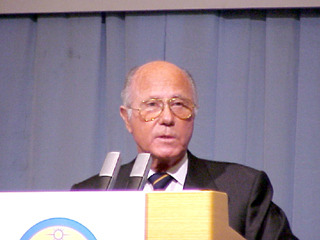
▲ Arnaud de Borchgrave speaks at the World Culture and Sports Festival '99 in Seoul Korea, February 1999. De Borchgrave's deep connections to the Public Information Office (PIO) reveal his own Gladio connections.
In 1950, de Borchgrave joined Newsweek as its Paris bureau chief and would stay with the magazine for thirty years, serving as Senior Editor from 1953 on and starring as its chief international correspondent throughout the 1960s and 1970s. During this period, de Borchgrave played a key role in the genesis of PIO; as Bougerol recalled in an interview, it was de Borchgrave who, in the early 1970s, introduced Bougerol to PIO's future patron, Benoît de Bonvoisin. According to a May 1981 Sûreté report on de Bonvoisin's contacts in Paris, de Borchgrave also allegedly acted as an intermediary between de Bonvoisin and the CIA.
In the late 1970s, de Borchgrave was one of PIO's prized foreign press contacts; when PIO chartered a plane to fly journalists to the Zairean province of Shaba in 1978, the plane had to wait on the tarmac for one late VIP - de Borchgrave. De Borchgrave subsequently filed reports for Newsweek alleging Cuban involvement in the Katangese invasion of Shaba; Moss drew attention to de Borchgrave's Newsweek articles in a piece he wrote for the Heritage Foundation's Policy Review in its Summer 1978 issue (262)*. De Borchgrave and Moss were already longstanding friends; they had met in 1972 when de Borchgrave, in hiding in London after writing an article on Black September for Newsweek, asked to meet a specialist on subversion (263). The meeting would herald the beginning of a long partnership between the two men which would reach its peak in the 1980s.
De Borchgrave would also benefit from close contacts with SDECE chief Alexandre de Marenches, who, when asked where would be an interesting place to spend the Christmas of 1979, advised de Borchgrave to go to Afghanistan. De Borchgrave was one of the few Western journalists on the spot during the Soviet invasion (264). De Borchgrave would be fired by Newsweek in 1980 after he was discovered to have been building files on his colleagues for several years. At the time, he was working with Robert Moss on the first of two notorious disinformation novels, The Spike and Monimbo, both heavily influenced by the veteran CIA Counter-Intelligence chief James Jesus Angleton and filled with plots of Soviet subversion launched with the assistance of the Sandinista government in Nicaragua and the complicity of left-wing journalists in Europe.
In 1985, de Borchgrave would become editor-in-chief of the Moonies' newspaper, the Washington Times. The Unification Church would be a forum for cooperation between de Borchgrave and Cline: Cline was on the Editorial Board of The World and I, the Moonies' monthly edited by de Borchgrave. De Borchgrave was a former Board member of the Moonies' US Global Strategy Council, chaired by Cline in the late 1980s. Cline and de Borchgrave also shared a platform with William Casey as speakers at a special conference series on intelligence held at the Ashbrook Center, Ohio in 1986, one of Casey's last public appearances before his death in May 1987. At this time, de Borchgrave was working with Moss and John Rees of the John Birch Society in a "risk analysis" company, Mid-Atlantic Research Associates (MARA); the three also edited a monthly private intelligence report called Early Warning (265)*.
Together, de Borchgrave and Robert Moss engaged in disinformation efforts and authored novels influenced by intelligence activities, Monimbó in 1983 and The Spike in 1980. Moss today is now grifting new age circles as a so-called shaman.

▲ An advertisement for a Robert Moss event In the early 1970s, de Borchgrave played a significant role in introducing key fascist figures to influential institutions, acting as an intermediary between them. He is said to have been the one who introduced Benoît de Bonvoisin to the Public Information Office (PIO) of the Belgian Ministry of Defence for the sake of funding. Bonvoisin became their primary patron. The PIO was publicly exposed as being infiltrated by and working with right-wing private intelligence entities and terroristic anti-communist organizations. Bonvoisin was also said to have been a major funder of, broadly, the far-right, funding countless Gladio operations beyond PIO.
In the 80s, he was a senior associate at the Georgetown University Center for Strategic and International Studies.
SUBCOMMITTEE ON SECURITY AND TERRORISM (1981) - chaired by Strom Thurmond
We have another international journalist of extensive experience in journalism and with the subjects on which he has written, including the subject of disinformation and espionage. He, too, is associated presently with the Center for Strategic International Studies at Georgetown University, Mr. Arnaud de Borchgrave.
De Borchgrave was also on the Board of Directors of the US Global Strategy Council, an organization closely associated with CAUSA chaired by former Deputy Director of the CIA Ray Cline, fellow disinformation specialist at the Center for Strategic and International Studies. "Inside the League” suggests that Asian People's Anti-Communist League (APACL) was also partially funded by CIA discretionary funds and/or U.S. Embassy Counterpart Funds transmitted through Ray Cline. Moon was a member of APACL during this period.
In 1985, de Borchgrave became the editor-in-chief of Moon’s Washington Times after pro-Pinochet James Whelan left the Washington Times, denouncing it as being under the command of Moon’s movement.
From ‘Arnaud de Borchgrave Boards Moon's Ship’ by Louis Wolf and Fred Clarkson in Covert Action Information Bulletin No. 24:
On March 20, 1985 the public was informed that Arnaud de Borchgrave was the new editor-in-chief of Reverend Sun Myung Moon’s newspaper, the Washington Times. Media analysts knew at once that Washington’s already shrill rhetoric would be reaching new heights.
Even before Ronald Reagan took office, de Borchgrave had ready access to the President-elect. On December 16, 1980, they met for a ‘‘very lengthy conversation’’ about disinformation, propaganda, and de Borchgrave’s recommendations for White House media strategy, nationally and internationally. That strategy must have paid off; de Borchgrave told the New York Times, ‘‘The Washington Times is the first thing Ronald Reagan reads each morning. He called me up and told me so.’’ (May 26, 1985.)
At the end of this article, Wolf and Clarkson wrote:
Asked whether the United States engages in disinformation, de Borchgrave said that present and former U.S. officials trying “in a free society . . . to put the best face possible” on what they are doing or did in government is not disinformation. “That is called the management of the news.”
Related articles and notes below
The World Anti-Communist League: the Internationale of Crime - Thierry Meyssan
On the Ramparts of Freedom - Arnaud de Borchgrave at the God and Freedom Banquet celebrating Reverend Moon's release from Danbury Prison, August 20, 1985
From Bo Hi Pak's Messiah - My Testimony to Rev. Sun Myung Moon Volume II - Pak on de Borchgrave
The Unification Church and the KCIA – ‘Privatizing’ covert action: the case of the UC - Lobster Magazine
Note: The Center for Strategic and International Studies was founded in 1962, the same year Bo HI Pak began studying part-time the Walsh School of Foreign Service at Georgetown University, after over a decade of intelligence work. From 1961-1964, Pak was working as the Assistant Military Attaché at the Korean Embassy, in constant communication with his bosses and colleagues at the KCIA and the US CIA. More on Georgetown University’s Center for Strategic and International Studies (CSIS) from The "Terrorism" Industry: The Experts and Institutions That Shape Our View of Terror by Edward S. Herman and Gerry O'Sullivan
The semipermanent terrorism experts of CSIS have been Ledeen, Laqueur, Kupperman, and Cline, but Yonah Alexander, Claire Sterling, Paul Henze, Arnaud de Borchgrave, and Robert Moss have been occasional participants in CSIS's activities bearing on terrorism. We noted earlier that the spectrum of terrorism opinion may be divided into three categories: (1) establishment moderate; (2) establishment far-right; and (3) critical and dissident. In this spectrum, of the four semipermanent and five transitory experts at CSIS, none fit category (3), only two (Laqueur and possibly Kupperman) fit category (1), and the seven others fall into category (2) right-wing extremist. The CSIS is not a "moderate" organization by this measure, or others noted above.
More on the United States Global Strategy Council from The "Terrorism" Industry: The Experts and Institutions That Shape Our View of Terror by Edward S. Herman and Gerry O'Sullivan
The council links together individuals connected with the Unification Church and other far-right operations (ASC, CIAS, and IFPA), to CSIS and the omnipresent Yonah Alexander. It has former officials Cline, Kirkpatrick, and Rumsfeld to lend respectability-to its terrorism studies. With this political cast, that South African viewpoints would be put in the frame of Soviet support and insurgent "terrorism" is a foregone conclusion.
More on “The Spike” by Arnaud de Borchgrave and Robert Moss - DE BORCHGRAVE (The Washington Post) - July 8, 1984
In two bestselling novels, The Spike (1980) and Monimbo (1983), de Borchgrave and coauthor Robert Moss lay out the scenario of this underground war, one battled with such subtlety by the enemy that most of us don't even know it's going on.
The story is one of classic decline and fall: barbarians (the Soviets) from without and decay (a media honeycombed with Marxist dupes) from within. The allegations of this plot have not gone unnoticed by some in the Reagan administration. At a Washington book party for Monimbo last September, administration figures who showed up included presidential counselor Edwin Meese, Attorney General William French Smith, USIA director Charles Wick and FBI director William Webster.
Because he has spent more than three decades as a reporter, The Spike and Monimbo aren't seen only as novels by de Borchgrave fans, but as thinly disguised accounts of what he thinks goes on in the media gulag. And because he spent so many years as a reporter, the vision of the world presented in the novels has many former colleagues scratching their heads about how he came to believe such a proposition.
1979 Assassination of U.S. Ambassador to Afghanistan Adolph Dubs Set Groundwork for America’s Longest War - Covert Action Magazine
Shortly before his death, Anwar Sadat admitted to the world the massive role played by the U.S. in the Afghan rebellion. He revealed. to the consternation of U.S. officials, that Egypt was the conduit for U.S. arms shipments to the rebels, suggesting a scale of paramilitary involvement even greater than had been suspected. U.S. intervention in Afghanistan even reached the Style’ section of the Washington Post in a recent note describing a propaganda film supporting the rebels. The film benefit was sponsored by a shadowy group called Youth for Understanding, which sends American students overseas in highly-controlled and isolated programs. YFU's board includes David Abshire, Director of the Center for Strategic and International Studies, base for many “retired” intelligence officers. Attending the screening were CIA Director William Casey and disinformation specialist Arnaud de Borchgrave.
#Arnaud de Borchgrave#u.s. government#cia#operation gladio#belgium#unification church in japan#moonies#robert moss#counterinsurgency#world anti-communist league#united press international#upi#journalism#newspapers#new age#u.s. global strategy council#causa#apacl#asian peoples' anti-communist league#wacl#georgetown university#walsh school of foreign service#intelligence agencies#europe
0 notes
Photo
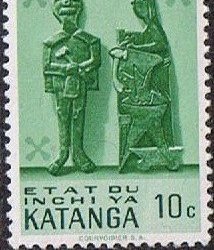
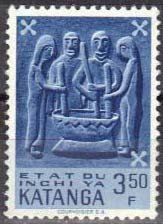


For a brief time in the early 1960s, the Province of Katanga declared its independence from the (also newly independent) Republic of Congo (Congo-Léopoldville, what was Belgian Congo and what is now the Democratic Republic of Congo) and called itself the State of Katanga. It was never recognized internationally, and even internally was wracked with instability and dissension. The UN eventually stepped in in 1963 and Katanga remains a part of the DRC.
Stamp details: Stamps on top: Issued on: March 1, 1961 From: Élisabethville, State of Katanga MC #52, 57, 64
Issued on: July 8, 1961 From: Élisabethville, State of Katanga MC #66
Recognized as a sovereign state by the UN: No Claimed by: Democratic Republic of Congo Member of the Universal Postal Union: No
#Katanga#State of Katanga#État du Katanga#Inchi Ya Katanga#Republic of Katanga#Democratic Republic of Congo#DRC#stamps#philately#April 6#Province du Katanga#Katanga Province#Shaba Province#Republic of Congo-Léopoldville#Moïse Tshombe
2 notes
·
View notes
Text
ADIEU GABRIEL D’OLIVEIRA KYUNGU WA KUMWANZA
Quelle mouche vous a piqué Mr le Président pour cracher sur la mémoire des congolaises et congolais d’origine kasienne comme vous, massacrés sauvagement sous l’instigation de l’homme que vous auréolé aujourd’hui ?
Décédé le 21 août 2021 à Luanda (Angola) à l'âge de 83 ans, Gabriel d'Oliveira Kyungu wa Kumwanza a eu droit à des obsèques grandioses Tout le leadership provincial katangais s'est senti concerné, et Baba a été enterré avec les honneurs (?) dus à son rang, pour reprendre l'expression consacrée. Au fait, il s'est offert un revirement de situation de nature à faire pâlir d'envie ses mentors Augustin Kibassa Maliba et Jean Nguz Karl I Bond, enterrés sans un seul geste d'humanité côté Udps...
LES « BILULU ».
Des oeuvres de Gabriel d'Oliveira Kyungu wa Kumwanza, celles à la base de sa réputation sulfureuse sont en vérité éloignées de la dignité, de la grandeur ou, pour faire simple, de l'humanité que veut lui reconnaître aujourd’hui Felix Tshisekedi et son régime.
Pour l'histoire, il est vrai qu'il est signataire de la Lettre des 13 Parlementaires adressée au maréchal Mobutu en 1980 pour dénoncer l'incurie caractérisant la gouvernance publique à l'époque du Mpr Parti-Etat. Incurie qu'il va reproduire dans sa province une fois nommé gouverneur du Shaba début 1990.
Pour l'histoire, il est également vrai qu'il est co-fondateur de l'UDPS en 1982. Parti qu'il va vilipender entre les années 1990 et 2015 au sein successivement du Pri, de l'Uféri et de l'Unafec.
Mais, pour la même Histoire, se joignant à d’autres leaders de sa province, Kyungu se découvrira la vocation de " tueur " du Kasaïen, sans distinction.
En effet, à partir des accords dits du Palais de Marbre en septembre 1991 jusqu'à la Conférence nationale souveraine en 1992, il va s'adonner à l'épuration ethnique. Ses exploits sont d'ailleurs répertoriés dans le Rapport Projet Mapping et il suffisait de peu qu’il se retrouve à la Haye.
Dans les réseaux sociaux, circule une vidéo qui contredit la tentative d'Etienne Tshisekedi de le dédouaner. En effet, dans la sienne, le Premier ministre élu de la Cns y attribue à Mobutu la responsabilité de ce qui fut tout de même un crime contre l'humanité. Or, dans sa propre vidéo, Gabriel Kyungu assume son plan de chasser de sa province tous les Kasaïens indistinctement. Il les qualifie de " Bilulu" ou insectes envahisseurs. Il faut visualiser la vidéo du conteur Pie Tchibanda pour réaliser l'ampleur du crime.
LE CAMELEON POLITIQUE
Quelle a cependant été la caractéristique première de ce personnage pompeusement appelé " Baba du Katanga " ? Celle d'un opportuniste voguant au gré des vagues du fleuve Congo, du lac Moëro ou Tanganyika, voire de la rivière Luapula : mobutiste sous Mobutu lorsque Kibassa et Nguz sont aux affaires, kabiliste du Mzee Laurent-Désiré Kabila et kabiliste de Joseph Kabila parce que les identifiant aux siens (Katangais), Gabriel d'Oliveira Kyungu va rejoindre Étienne Tshisekedi en 2016 dès l'apparition des premiers signaux de l'alternance.
Il se fait alors la caution katangaise à Étienne puis, plus tard, à Félix Tshisekedi, si bien que lors de son dernier passage à Lubumbashi, Fatshi le présentera, toute honte bue, en unique katangais de confiance. Exit Moïse Katumbi, Jean-Claude Muyambo etc. contraints à se faire voir ailleurs.
BELTCHIKA versus MBIKAYI
Le fait de voir aujourd'hui la communauté kasaienne dopée par Félix Tshisekedi, hier très montée contre l'organisateur de l'épuration ethnique dont elle avait été victime au Katanga, se mobiliser pour honorer la mémoire de cet homme a quelque chose de renversant.
Dans l'espace Kasaï - au pays comme à l'étranger- c'est plus qu'une déception : c'est un choc.
En effet, qui s'attendait un jour à ce qu’un ressortissant du Kasai puisse affréter un avion pour Lubumbashi en vue de rendre des hommages à celui-là même qui organisa le massacre et les pillages contre ses membres ? Je crois rêver d’entendre une personnalité de la trempe de François Xavier Beltchika promettre " d'incarner l’idéologie de Gabriel Kyungu " caractérisée par la tuerie verbale et charnelle facile envers les Kasaïens et les autres compatriotes ?
Peut-être qu'aurait-il fallu un autre kasaïen, Steve Mbikayi, lui aussi membre de l'Union sacrée, pour rappeler à la conscience collective tout le mal que le défunt a fait aux Congolais ! Dans une déclaration publiée le 22 août 2021, il est certes d'avis que “ La mort exige de faire abstraction des défauts de ceux qui nous quittent ”. Mais, il est aussi d'avis que “S’il est malsain de parler du mal d’un mort, quels que soient ses défauts ou les préjudices causés à autrui de son vivant, il est aussi hypocrite pour un juif de louer les qualités d’Hitler après sa mort ! ”.
C'est vrai qu'en 2016, lorsqu'il avait vu Kyungu wa Kumwanza fuir la Majorité présidentielle pour se joindre à la dynamique de Genval, Steve Mbikayi avait porté plainte à charge au parquet de Kinshasa Gombe pour épuration des Kasaïens, estimant qu'" Il faut que les responsables de ces massacres soient poursuivis, jugés et condamnés ". Dans sa plainte, il avait rappelé que " Après l’élection de M. Etienne Tshisekedi à la Conférence nationale souveraine, il y a eu liesse populaire. A cette époque, certains leaders avaient demandé que les Kasaïens soient chassés, battus et tués au Katanga. Il y a eu des milliers de morts qui ont été enterrés dans la brousse, entre Lubumbashi et Ilebo. La plupart ont laissé leurs biens au Katanga ».
RAPPEL DU POGROM
Libre aujourd'hui à Félix Tshisekedi, en tant que président de la République, à son gouvernement, à son cabinet et à son parti d'accorder absolution à Gabriel D'Oliveira Kyungu pour tout le mal fait au pays, particulièrement à la communauté kasaienne. C'est, du reste, la preuve d'une grandeur d'âme.
Pendant qu'on n'y est, d'aucuns se demandent si la mobilisation observée dans le chef du président de la République, du gouvernement, de l'Union sacrée et de l'Udps aurait été la même pour Gabriel d'Oliveira Kyungu mort alors membre du Fcc !
Assurément, on aurait assisté à une campagne lui rappelant son pogrom.
Socrate Tshamala
1 note
·
View note
Text
Teacher In China Sent To Mental Hospital After Criticizing The Communist Party
Teacher In China Sent To Mental Hospital After Criticizing The Communist Party
Authorities in Hunan, China’s central province, are alleged to be keeping a teacher in a mental facility after she spoke out against the expulsion of a Shanghai journalism instructor who encouraged her pupils to check official versions of the Nanjing massacre. After officials from her hometown of Shaba in Hunan’s Yongshun county attempted to have her committed for mental care, schoolteacher Li…

View On WordPress
0 notes
Photo

Sparkling Green Malachite Stalactite Crystal Cluster from the Star of the Congo mine-Shaba Province, D.R.C.
Photo: http://BlueSkyMinerals.net
Amazing Geologist
65 notes
·
View notes
Text
Phuket threatens tourists with 'penalties' for rule breaking

There will be penalties for people who break their 14-day mandatory stay in Phuket as the provincial government has been given full authority to impose a fine or withdraw quarantine-free privilege from tourists.
It may all be academic anyway as the signs are that very few people are planning to spend their first trip away in what amounts to a juvenile detention centre. Even so, the little men in charge of everybody's lives in Phuket have been throwing their 55kg around again. The regulations, published in the Royal Gazette, not only grants permission to Phuket to reopen without quarantine to inoculated tourists but also authorised nine other pilot areas to reopen in the next stage but with different rules and restrictions based on the situation of each province, said Yuthasak Supasorn, Tourism Authority of Thailand (TAT) governor. The standard operating procedures (SOP) will include penalties for travellers who breach health safety regulations imposed by local disease control departments. It is up to each provincial governor or provincial command centre to determine which health safety measures are suitable for their geography and consider charges against people who fail to follow the rules. For Phuket, the province mandates a 14-day stay on the island in July. The province issued an order on June 25 stating that both Thais and foreigners who do not comply with control measures may face punishment as stated in Section 51 and 52 of disease control laws which includes a fine of up to 20,000 baht and 100,000 baht, respectively. However, Mr Yuthasak said punishments might be made less severe when the Phuket sandbox comes into effect on Thursday. The authorities might consider lighter punishments such as revoking quarantine exemptions and requiring tourists to lodge in alternative local quarantine if found guilty. "There shouldn't be any problem as tourists have already expressed their intention to stay longer on the island. As noted on the SHA Plus Booking Authentication System , the average length of stay for the first 15 days of this project was at 11.9 nights per guest," he said. SHABA is the back-end system that ensures that tourists complete mandatory stays in Phuket. It can track bookings and the payments tourists have already made to hotels certified under the Thailand Safety and Health Administration (SHA Plus) prior to arrival. Mr Yuthasak said Koh Samui, Krabi, Phangnga should be the next destinations to reopen to vaccinated tourists using a similar approach as Phuket. However, the timeline of each area depends on flight operations as the Civil Aviation Authority of Thailand (CAAT) has to grant permission and provide specific regulations to airports and airlines that want to fly direct to Samui and Krabi. Siripakorn Cheawsamoot, TAT deputy governor for Europe, Africa, the Middle East and the Americas, said there are at least 217 guests who have already booked and paid for hotel rooms for July 1. During the first two weeks of reopening, 1,101 bookings totalling about 13,000 room nights have been made with SHA Plus hotels. He said Bangkok Airways and Qatar Airways have confirmed their interest to serve international flights to Samui, however, due to a short runway, the airport can accommodate just narrow-bodied jets which cannot fly long-haul routes. "We still need CAAT to decide to allow inbound tourists to transit at Suvarnabhumi Airport which will be more practical," Mr Yuthasak said. https://bangkokjack.com/2021/06/13/no-point-phuket-reopening/ Read the full article
0 notes
Photo

Malachite (concentric growth malachite polished slice) Kolwezi District, Katanga (Shaba) Province, Democratic Republic of the Congo
285 notes
·
View notes
Text
Events 5.12
254 – Pope Stephen I takes office, and takes a stand against Novatianism. 907 – Zhu Wen forces Emperor Ai into abdicating, ending the Tang dynasty after nearly three hundred years of rule. 1191 – Richard I of England marries Berengaria of Navarre in Cyprus; she is crowned Queen consort of England the same day. 1328 – Antipope Nicholas V, a claimant to the papacy, is consecrated in Rome by the Bishop of Venice. 1364 – Jagiellonian University, the oldest university in Poland, is founded in Kraków. 1510 – The Prince of Anhua rebellion begins when Zhu Zhifan kills all the officials invited to a banquet and declares his intent on ousting the powerful Ming dynasty eunuch Liu Jin during the reign of the Zhengde Emperor. 1551 – National University of San Marcos, the oldest university in the Americas, is founded in Lima, Peru. 1588 – French Wars of Religion: Henry III of France flees Paris after Henry I, Duke of Guise, enters the city and a spontaneous uprising occurs. 1593 – London playwright Thomas Kyd is arrested and tortured by the Privy Council for libel. 1743 – Maria Theresa of Austria is crowned Queen of Bohemia after defeating her rival, Charles VII, Holy Roman Emperor. 1778 – Heinrich XI, count of the Principality of Reuss-Greiz, is elevated to Prince by Joseph II, Holy Roman Emperor. 1780 – American Revolutionary War: In the largest defeat of the Continental Army, Charleston, South Carolina is taken by British forces. 1797 – War of the First Coalition: Napoleon I of France conquers Venice. 1821 – The first major battle of the Greek War of Independence against the Turks is fought in Valtetsi. 1846 – The Donner Party of pioneers departs Independence, Missouri for California, on what will become a year-long journey of hardship and cannibalism. 1862 – American Civil War: U.S. federal troops occupy Baton Rouge, Louisiana. 1863 – American Civil War: Battle of Raymond: Two divisions of James B. McPherson's XVII Corps turn the left wing of Confederate General John C. Pemberton's defensive line on Fourteen Mile Creek, opening up the interior of Mississippi to the Union Army during the Vicksburg Campaign. 1864 – American Civil War: The Battle of Spotsylvania Court House: Union troops assault a Confederate salient known as the "Mule Shoe", with the fiercest fighting of the war, much of it hand-to-hand combat, occurring at "the Bloody Angle" on the northwest. 1865 – American Civil War: The Battle of Palmito Ranch: The first day of the last major land action to take place during the Civil War, resulting in a Confederate victory. 1870 – The Manitoba Act is given the Royal Assent, paving the way for Manitoba to become a province of Canada on July 15. 1881 – In North Africa, Tunisia becomes a French protectorate. 1885 – North-West Rebellion: The four-day Battle of Batoche, pitting rebel Métis against the Canadian government, comes to an end with a decisive rebel defeat. 1888 – In Southeast Asia, the North Borneo Chartered Company's territories become the British protectorate of North Borneo. 1926 – The Italian-built airship Norge becomes the first vessel to fly over the North Pole. 1932 – Ten weeks after his abduction, Charles Jr., the infant son of Charles Lindbergh, is found dead near Hopewell, New Jersey, just a few miles from the Lindberghs' home. 1933 – The Agricultural Adjustment Act, which restricts agricultural production through government purchase of livestock for slaughter and paying subsidies to farmers when they remove land from planting, is signed into law by President Franklin D. Roosevelt. 1937 – The Duke and Duchess of York are crowned as King George VI and Queen Elizabeth of the United Kingdom of Great Britain and Northern Ireland in Westminster Abbey. 1941 – Konrad Zuse presents the Z3, the world's first working programmable, fully automatic computer, in Berlin. 1942 – World War II: Second Battle of Kharkov: In eastern Ukraine, Red Army forces under Marshal Semyon Timoshenko launch a major offensive from the Izium bridgehead, only to be encircled and destroyed by the troops of Army Group South two weeks later. 1942 – World War II: The U.S. tanker SS Virginia is torpedoed in the mouth of the Mississippi River by the German submarine U-507. 1948 – Wilhelmina, Queen regnant of the Kingdom of the Netherlands, cedes the throne. 1949 – Cold War: The Soviet Union lifts its blockade of Berlin. 1965 – The Soviet spacecraft Luna 5 crashes on the Moon. 1968 – Vietnam War: North Vietnamese and Viet Cong forces attack Australian troops defending Fire Support Base Coral. 1978 – In Zaire, rebels occupy the city of Kolwezi, the mining center of the province of Shaba (now known as Katanga); the local government asks the US, France and Belgium to restore order. 1982 – During a procession outside the shrine of the Virgin Mary in Fátima, Portugal, security guards overpower Juan María Fernández y Krohn before he can attack Pope John Paul II with a bayonet. 1989 – The San Bernardino train disaster kills four people, only to be followed a week later by an underground gasoline pipeline explosion, which kills two more people. 1998 – Four students are shot at Trisakti University, leading to widespread riots and the fall of Suharto. 2002 – Former US President Jimmy Carter arrives in Cuba for a five-day visit with Fidel Castro, becoming the first President of the United States, in or out of office, to visit the island since Castro's 1959 revolution. 2003 – The Riyadh compound bombings, carried out by al-Qaeda, kill 26 people. 2006 – Mass unrest by the Primeiro Comando da Capital begins in São Paulo (Brazil), leaving at least 150 dead. 2006 – Iranian Azeris interpret a cartoon published in an Iranian magazine as insulting, resulting in massive riots throughout the country. 2008 – An earthquake (measuring around 8.0 magnitude) occurs in Sichuan, China, killing over 69,000 people. 2008 – U.S. Immigration and Customs Enforcement conducts the largest-ever raid of a workplace in Postville, Iowa, arresting nearly 400 immigrants for identity theft and document fraud. 2010 – Afriqiyah Airways Flight 771 crashes on final approach to Tripoli International Airport in Tripoli, Libya, killing 103 out of the 104 people on board. 2015 – A train derailment in Philadelphia kills eight people and injures more than 200. 2015 – Massive Nepal earthquake kills 218 people and injures more than 3500. 2017 – The WannaCry ransomware attack impacts over 400,000 computers worldwide, targeting computers of the United Kingdom's National Health Services and Telefónica computers. 2018 – Paris knife attack: A man was fatally shot by police in Paris after killing one and injuring several others.
0 notes
Text
Hotels in Nanyuki, Mt.Kenya, Aberdares, Laikipia & Samburu

Hotels in Nanyuki, Mt.Kenya, Aberdares, Laikipia & Samburu Ashnil Samburu Camp -Samburu National Reserve Ashnil samburu Camp is located in Buffalo Springs Game Reserve separated from Samburu National Reserve only by Ewaso Nyiro River. Borana Lodge -Borana Lodge is located in the outskirt of Nanyuki situated on a 35,000-acre, wildlife rich, private and working cattle ranch. Elephant Bedroom Camp -Samburu National Reserve Elephant Bedroom Camp is located in the outskirts of Nanyuki nesteled on the banks of Ewaso Nyiro River in Samburu National Reserve. El Karama Eco Lodge - El Karama Eco Lodge is a 14,000 acre, family-run cattle and wildlife ranch, operational since 1963. Elsa's Kopje - Elsa’s Kopje Lodge is a luxurious oasis in the wilds of Meru National Park, Kenya. Enasoit Ranch - Enasoit lies in a wildlife corridor overlooking a waterhole, the Lolldaiga Hills creating a beautiful background. Fairmont Mt Kenya Safari Club -Fairmont Mt Kenya Safari Club is located in Nanyuki, situated on the slopes of Mt Kenya. Falcon Heights Hotel -Falcon Heights Hotel, is a 5 star boutique hotel located 20 minutes away from Nanyuki town offering modern day facilities in a lush surrounding. Il N'gwesi Lodge -Il N'gwesi Lodge is located in a community owned ranch slightly north of Mount Kenya on the outskirts of Nanyuki town. Joy's Camp -Shaba National Reserve Joy's Camp is situated in Shaba National Reserve a semii desert with a rugged hilly terrain, with great rocky kopjes and lots of springs supporting the abundant wildlife. Kalacha Camp - Kalacha Camp is located in the Chalbi Desert, North Eastern Kenya, sits on the edge of a permanent oasis, fed by a natural artesian well. Kicheche Laikipia Camp - Kicheche Laikipia Camp is located at the centre of the Ol Pejeta Conservancy in the outskarts of Nanyuki. Kifaru House -Kifaru House is located on the 62,000-acre Lewa Wildlife Conservancy. Kitich Camp -Kitich Camp is located in Mathews Mountain Ranges covered in dense levey forest in the outskirts of Nanyuki. Koija Starbeds Lodge -Koija is located to a private wildlife conservancy, loisaba wilderness on the edge of the Laikipia plateau, on the banks of the Ewaso Nyiro river. Kongoni Camp - Kongoni Camp Hotel is situated less than 2km from Nanyuki town northwest of Mt Kenya off Meru road. Laragai House -Laragai House is located in the outskirts of Nanyuki town, sitting at the edge of a plateau eight Km from the lodge. Larsens Tented Camp - Larsens Camp is located in Kenya’s famous Samburu National Reserve. Lewa House - Lewa House is located in the outskats of Nanyuki town satuated within the 62,000 acres of Lewa Wildlife Conservancy on the northern slopes of Mt Kenya. Lewa Safari Camp - Lewa Safari Camp is located in the outskirts of Nanyuki situated in the conservancy of Lewa Wilderness. Lewa Wilderness - Lewa Wilderness Trails Lodge is located in the Lewa Conservancy at the slopes of Mt Kenya in the outskirts of Nanyuki Town. Loisaba House -Loisaba House is located in the outskirts of Nanyuki, at the slopes of the largest mountain in Kenya, Mt Kenya. Loisaba Wilderness Lodge -Loisaba Wilderness Lodge is located on the outskirts of Nanyuki town on the edge of a plateau looking the south towards Mt Kenya. Mukima House -Mukima House is located in a private ranch, 15 minutes drive from Nanyuki town with a clear view of Mt Kenya. Mukutan Retreat - Mukutan Retreat is situated on the West of Laikipia on the 100,000 acre, Laikipia Nature Conservancy. Mutamaiyu House -Mutamaiyu House is located in the out skirts of Nanyuki town on Mugie Ranch, a 49,000 acre working ranch. . Nanyuki Sports Club -Situated in Rift Valley Kenya, the Nanyuki Sports Club was established in 1926. Ngobit River Lodge - Ngobit River Lodge situated on 50 acres along the Ngobit River with a 1 km frontage. Ol Malo House - Ol Malo is a privately-owned Game sanctuary on the banks of the Uaso Nyiro River in Kenya's wild and beautiful North Eastern Province. Ol Pejeta Bush Camp - Ol Pejeta Bush Camp is camp is located in Ol pageta conservancy on the bank of the Ewaso Nyiro River. Kongoni Camp - Kongoni Camp Hotel is situated less than 2km from Nanyuki town northwest of Mt Kenya off Meru road. Sabuk Lodge -Sabuk Lodge is located in the North Central Kenya set on the plateau along the Ewaso Nyiro river in the outskirts of Nanyuki. Mid-RangeSamburu Intrepids Camp - Samburu National Reserve Samburu Intrepids is situated on the banks of the Ewaso Nyiro River in the arid heart of Samburu National Reserve. Sarova Shaba Lodge - Sarova Shaba Lodge is situated deep in the arid Northern part of Kenya. Across the Great North Road, is Shaba National Reserve. Sere Enkang Lodge -Sere Enkang is an incredible lodge set on the natural and serene environment near the famous Mt Kenya along Nairobi- Nanyuki highway. Sosian Ranch - Sosian lies in Laikipia, Kenya's High Country, only 50km from the Equator in the foothills of Mt. Kenya. Ashnil Samburu Camp -Samburu National Reserve Ashnil samburu Camp is located in Buffalo Springs Game Reserve separated from Samburu National Reserve only by Ewaso Nyiro River. Elephant Bedroom Camp -Samburu National Reserve Elephant Bedroom Camp is located in the outskirts of Nanyuki nesteled on the banks of Ewaso Nyiro River in Samburu National Reserve. Timau River Lodge -Timau River lodge is located only 1 km from Nanyuki-Samburu road and is surrounded by 800 acres of cider forest. Falcon Heights Hotel - Falcon Heights Hotel, is a 5 star boutique hotel located 20 minutes away from Nanyuki town offering modern day facilities in a lush surrounding. Kalacha Camp -Kalacha Camp is located in the Chalbi Desert, North Eastern Kenya, sits on the edge of a permanent oasis, fed by a natural artesian well. Nanyuki Sports Club - Situated in Rift Valley Kenya, the Nanyuki Sports Club was established in 1926. Mid-RangeNgobit River Lodge - Ngobit River Lodge situated on 50 acres along the Ngobit River with a 1 km frontage. Read the full article
0 notes
Photo




Mon passage à Lubumbashi dans le Haut Katanga.
Lubumbashi est, selon les estimations, la deuxième ou troisième ville de la République démocratique du Congo quant au nombre d'habitants, titre disputé avec Mbuji-Mayi. Elle est devancée par Kinshasa. Lubumbashi était le chef-lieu de la province du Katanga (temporairement Shaba sous le règne de Mobutu) jusqu'en 2015. Elle devient ensuite le chef-lieu de la province du Haut-Katanga.
Lubumbashi est aussi appelée capitale du cuivre1.
Fondée en 1910 par les Belges sous le nom d'Élisabethville ou Elisabethstad (d'après Élisabeth de Bavière, devenue reine des Belges)1, souvent abrégée en « E'ville »2, la ville fut renommée Lubumbashi en 1965. Elle fut aussi la capitale de l'éphémère État autoproclamé du Katanga (1960-1963), né sous l'impulsion de Moïse Tshombe.
Elle est le siège de plusieurs grandes sociétés congolaises, ou à capitaux étrangers, dont la Société nationale des chemins de fer du Congo, la Gécamines, Rwuashi Mining et KICC (Metorex Group companies), Anvil Mining sprl (Mawson West RDC), Société de Traitement du Terril de Lubumbashi (STL), Tenke Fungurume Mining (Freeport MacMoran), Phelps Dodges RDC, ou encore le groupe George Forrest.
La prison de Kasapa est située au nord de Lubumbashi, actuellement non loin des nouveaux lotissements attribués à leurs nouveaux acquéreurs, se retrouvant ainsi trop rapprochée de la ville et de son peuple. Cette prison est recensée parmi les plus grandes prisons du pays avec une importante population carcérale. Ensemble avec la prison Centrale de Makala à Kinshasaet celle de Buluwo à Likasi, elles sont réputées comme étant les plus sécurisées de la République démocratique du Congo
Wikipédia
0 notes
Note
Poor them. They will never know the joys of a dawn ka paratha and pathaan ki chai
(for anyone confused as fuck, shaba a are like tiny local broken down cafes where they serve you breakfast and it's amazing. Dawn ka paratha is literally like a friend chapati by a company called Dawn and it is HEAVENLY and pathaan are people called from the province of kpk and their tea is goddamn brilliant)
how the fuck do you not know what tim hortons is
i think ive said this more today than i have in hte rest of my life but im american and i dont know shit
40 notes
·
View notes
Text
Space Ambitions
1977:President Mobutu Sésé Seko intended that the launch, on 17 May, of a rocket from Shaba province, in eastern Zaïre, would set the country on course to join the select club of space nations. The rocket, designed and built by the West German company OTRAG as an inexpensive alternative to NASA and European Space Agency rockets, reached an altitude of 20 kilometres. But any hopes that Shaba would…
View On WordPress
#1977#Cape Canaveral#David van Reybrouck#European Space Agency#Mobutu Sésé Seko#NASA#OTRAG#Shaba#Space Travel#West Germany#Zaïre
0 notes
Text
Last weeks bookmarket brought a surprise. There was this catalogue published by KIT on the dramatic history of the Congo as painted by Tshibumba Kanda Matulu / TKM.
This catalogue/book is now available at www.ftn-books.com
TKM was born in Élisabethville (modern-day Lubumbashi), in the south of the Belgian Congo, in 1947. TKM worked within the period of cultural authenticité in the 1970s.[2] TKM was one of the leading figures of “African genre painting” which had emerged in the Belgian Congo in the late 1950s and which integrated both European and Congolese styles and techniques.
TKM’s best-known paintings form part of a series of 107 works commissioned by the German anthropologist Johannes Fabian to illustrate Congolese history as it appeared in national collective memory. The series was produced between 1974 and 1976 and forms the body of TKM’s work and was used as the basis for an academic collaboration between the two.[2] The result, Remembering the Present: Paintings and popular history in Zaire, was published in 1996. TKM viewed the purpose of the book as presenting the history of his country to a child born in the country. by contrast, Fabian presents it as an anthropological work for Western study.
Among the scenes depicted by TKM was the Elisabethville Massacre of 1941, Patrice Lumumba’s independence speech of 30 June 1960, the introduction of culture obligatoire farming, and the trial of the religious leader Simon Kimbangu by the Belgian colonial authorities in 1921. All the paintings were made at the time of the Shaba Invasions during which TKM’s native province of Shaba witnessed widespread political instability.
The work is historically significant because of the interviews between Fabian and TKM included in the work. In those interviews, TKM subtly critiques the government of Mobutu Sese Seko, making statements such as “What Mobutu has in mind is true – or else it is a lie. But that’s something I keep to myself. What is true is that he started out with ideas that were correct. So he spoke and we all agreed; not a single thing was disputed.”
The work also emphasizes TKM’s admiration of Patrice Lumumba, particularly in the use of deliberate Christ imagery in the paintings of Lumumba, specifically mirroring Jesus’ wounds after the crucifixion. The parallel is so clear that Fabian names the section “The Passion of Patrice Lumumba,” a reference to “The Passion of the Christ.”
102 of TKM’s paintings were purchased by the Tropenmuseum, an ethnographic museum in Amsterdam, in 2000
TKM disappeared in 1981 and is believed to have been killed in rioting.
So far the history of this African artist. Personally i think this is an important oeuvre although i have doubts about the artistic value. Still …ALL of the paintings have a strong power and presence and perhaps that is what great art always is.
Tshibumba Kanda Matulu ( 1947 – 1981) Last weeks bookmarket brought a surprise. There was this catalogue published by KIT on the dramatic history of the Congo as painted by Tshibumba Kanda Matulu / TKM.
0 notes